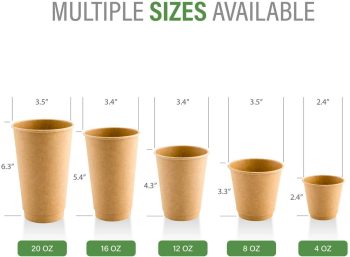In recent years, there have been several innovations in paper cup manufacturing aimed at improving sustainability, functionality, and overall environmental impact. These innovations address issues such as recyclability, compostability, resource conservation, and waste reduction. Here are some notable innovations:
- Water-Based Barrier Coatings: Traditional paper cups are often coated with wax or plastic to make them waterproof. Water-based barrier coatings are an eco-friendly alternative that provides similar functionality while being more compatible with recycling processes.
- Compostable Lining Materials: Some manufacturers have developed compostable linings made from plant-based materials, such as polylactic acid (PLA) or bio-based plastics. These linings break down more readily in composting facilities compared to traditional plastic linings.
- Recyclable Paper Cups with Separable Linings: Innovations in cup design now allow for easier separation of the paper and lining, enhancing the recyclability of paper cups. This process involves creating cups with liners that can be peeled off more effectively during the recycling process.
- Recycled Fiber Content: Paper cups with a higher percentage of post-consumer recycled fiber reduce the demand for virgin materials and contribute to a circular economy.
- Paper Sourcing and Responsible Forestry Practices: Manufacturers are increasingly using sustainably sourced paper from responsibly managed forests, ensuring that the production of paper cups has a minimal impact on ecosystems.
- Circular Economy Models: Some manufacturers are exploring closed-loop systems where used cups are collected, recycled, and incorporated into the production of new cups. This reduces the need for new raw materials and minimizes waste.
- Innovative Cup Designs: Manufacturers are creating new cup designs that enhance functionality, such as improved insulation, spill-resistant lids, and ergonomic shapes that enhance the user experience.
- Plant-Based Inks: Environmentally friendly, plant-based inks are being used for printing on paper cups, reducing the use of petroleum-based inks and minimizing harmful emissions.
- Smart Packaging: Technology is being integrated into paper cups to provide interactive and informative experiences for consumers. QR codes, NFC tags, or augmented reality elements can offer product information, promotions, and sustainability tips.
- Hybrid Materials: Some manufacturers are experimenting with combining paper with other biodegradable materials like bamboo fibers to create cups with enhanced durability and eco-friendliness.
- Waste-to-Energy Conversion: In some regions, used paper cups are being converted into energy through waste-to-energy processes, where the cups are incinerated to generate electricity or heat.
- Public Awareness Campaigns: Manufacturers and industry organizations are raising awareness about the environmental impact of paper cups and encouraging consumers to recycle properly and make sustainable choices.
These innovations are collectively contributing to a more sustainable future for paper cup manufacturing. As consumer demand for eco-friendly products continues to grow and technology advances, the industry is likely to see even more creative solutions that reduce waste, promote recycling, and align with green initiatives.





















